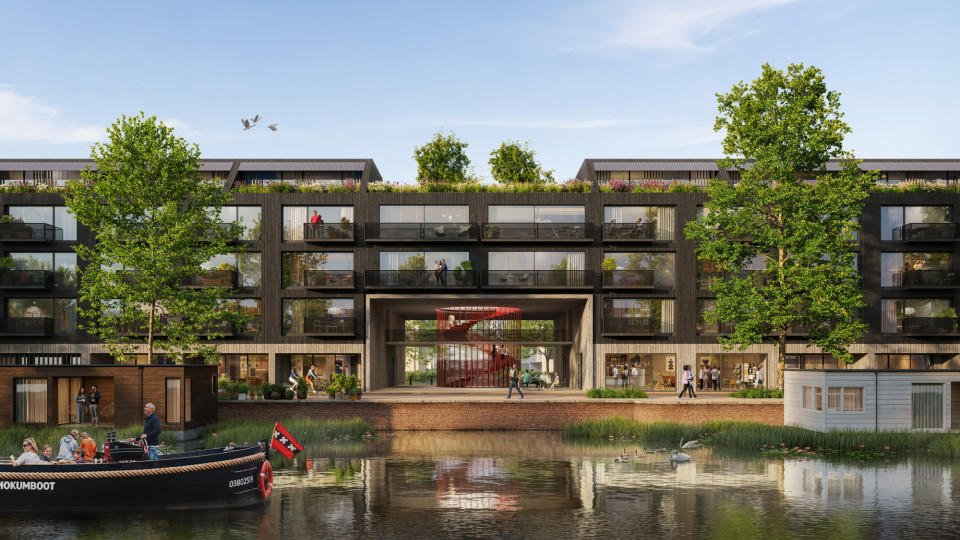A sustainable social housing complex
In 2010, the Mijdrechtse Twistvlied School was closed due to a declining number of students. Now, years later, the site has been repurposed. The former school grounds now house the Twistvlied housing complex, designed to meet the growing demand for affordable starter homes in the municipality of De Ronde Venen.
Twistvlied consists of 50 sustainable, energy-neutral homes spread over three floors. The building offers 26 social rental apartments and 24 starter apartments for sale, with sizes ranging from 32 to 50 square meters. In collaboration with HSB Bouw, we have realized this housing block with an emphasis on combining high quality and sustainability in social housing.
Architecture: individual recognizability and special masonry
The strength of Twistvlied lies in the individual recognizability of the houses. This is achieved by splitting the building into separate houses standing next to each other and placing the terraces of the apartments internally above each other. The masonry, with earthy red-brown bricks and the application of unique patterns, further contributes to this recognizability. Vertical masonry in the horizontal bands and textured, protruding masonry in the partition walls between the homes, along with the recessed volume of the balconies, ensure that the building is visually segmented. All homes feature a separate bedroom, a high-quality bathroom and kitchen, an internal storage room, and an outdoor space such as a balcony or private terrace. Each home is also equipped with three solar panels, an air-source heat pump, underfloor heating, and a heat recovery ventilation system (HRV). The large floor-to-ceiling windows with anthracite aluminum frames provide plenty of daylight in the homes and offer expansive views of the surroundings.
- - Ronald Hageman (Bouwkundig Ontwerper, Paul de Ruiter Architects)
A lively, omnidirectional building
Another quality of Twistvlied is the abundance of greenery surrounding the homes. By making the ground floor homes accessible via a central corridor inside, the building becomes omnidirectional, with each home having its own outdoor space. These private terraces are separated by green hedges for privacy, without built structures between the terraces and the communal green area. This design makes the terraces appear accessible, fostering a sense of community and liveliness in the neighborhood. The extensive greenery around the building extends along the facade, thanks to the special masonry that supports climbing plants. This creates a vibrant base and provides extra living space for fauna. Biodiversity is further enhanced by the bee stones and bat boxes (both nocturnal and nesting shelters) placed in the gable ends. The parking area features grass tiles, which not only improve rainwater drainage and reduce waterlogging but also contribute to a greener, more attractive environment, temperature regulation, sustainability, and biodiversity. Additionally, there is a communal garden with fruit trees and vegetable plots, preventing residents on the parking side from looking directly at cars and offering an extra space for meeting and greenery.
Around a central heart
Interaction between residents is also facilitated inside. Upon entering the central entrance hall, there is a communal bicycle storage area. This area is transparent, encouraging residents to use their bikes while also promoting social safety. A staircase next to the bicycle storage leads up to the central atrium, which benefits from an abundance of natural light thanks to a large skylight. At the center of this atrium is a large planter with lush greenery. By having the staircase run alongside this green oasis, residents are encouraged to use the stairs, though there is also an elevator that opens into the atrium. Seating around the large planter, as well as features like picture rails in the corridors, make it easier for residents to undertake initiatives such as hanging artwork and foster a sense of ownership over the building. All corridors are directly connected to this vibrant heart of the building and end with a large window at the far end to allow ample daylight to enter.
Project details
Gegevens
| Location | Mijdrecht, Netherlands |
| Total floor area | 3000 m2 |
| Project description | 24 social housing en 26 social rental housing |
| Completion | 2024 |
Ontwerpteam
| Client | HSB Ontwikkeling |
| Design | Paul de Ruiter Architects |
| Project team | Paul de Ruiter, Ronald Hageman, Milda Auksele, Yamoh Rasa, Hidde Dijkstra |
| Contractor | UBA Bouw |
| Construction consultant | VeriCon (previous Adams Bouwadviesbureau) |
| Sustainability consultant | Groot Ecobouw |
| Structural engineering | INNAX (previous Technisch Adviesbureau Duinwijck) |
| Artist | MISS3 |
| Photographer | Aiste Rakauskaite |










